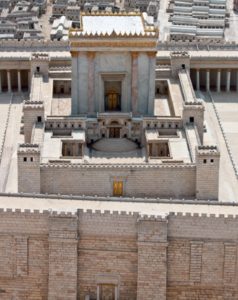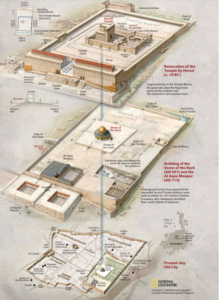The most important building in Jerusalem during the times of Jesus was its temple. The building, having been expanded by Herod, was built on an elevated surface, of near rectangular shape, more than five hundred meters in length and three hundred meters in width. That great open-air esplanade was surrounded by a portico of pillars. It had a surface of some 144.000 square meters. The first great space surrounded by columns was called the “atrium of the gentiles” because everyone was allowed to enter it, even non-jews.
In the middle of the esplanade there was a second zone, a bit more elevated, and fenced-in with a warning that non-jews who entered there would be exposing themselves to mortal danger. We still have one of the stones with the warnings in Greek which read: “No foreigner may enter within the balustrade around the sanctuary and the enclosure. Whoever is caught, will himself be to blame for the death which will ensue.” That second zone of the temple consisted in another atrium and portico which was accessed via the “Beautiful Gate.” Entrance was reserved to the men and women of Israel who went there to pray, obtain blessings from the priests, or give alms.

Temple of Jerusalem, Alberto Peral, Ministry of Tourism Israel
Within it, another large gate gave way to a third space reserved for men who were going to present their alms or offer sacrifices. It held the altar, a tall surface with horns in its corners and inside which fire always burned. Priests were the only ones allowed to walk up the ramp that led to the altar. Around it one found the tables to quarter the offerings and a large bronze water basin for purifications.
Inside that third atrium where sacrifices took place, one could see the majestic façade of the sanctuary, square, about sixty meters on each side. Past it was a vestibule that was wide but not too dep, the ulam, which was the entrance to the sanctuary (hekal) of rectangular shape, its walls adorned in gold plating. In that room was the candlestick with seven arms (menorah), the altar for incense and the table for the bread, all of them made of gold. A grand, splendid curtain separated that stage from the most interior one, the Holy of Holies (debir), a square room. In Solomon’s temple it was the place where, according to the Bible, the Ark of the Covenant was kept. But in the temple rebuilt by Herod it stood completely empty. Only the High Priest was allowed inside once a year, on the feast of Yom Kippur.
The Temple of Jerusalem was thus a grand enclosure, most of it in open air, full of dividers between the successive spaces which configured it: the exterior portico that surrounded the atrium of the gentiles, the fencing that restricted the zone where only Israelite men and women could access, the wall that separated that common area from the place where only men could enter with their victims for sacrifices and which in turn held another area, a bit more elevated, which displayed the altar and was reserved for the priests; and from which one could reach, behind the vestibule, the Sanctuary and the Holy of Holies in that order. This is not an arbitrary floorplan; it holds a theological background, because it serves to express the sanctity of God.
The Lord, in the Old Testament, is the Only Saint, who provokes man to fear and admiration, recognition of his majesty and an impulse to hide before his grandiose presence. The ordinary life of man on earth takes place among the profane, and the transition from one sphere to another requires a radical transformation. Because God exists in a «holy» domain, relating to him without harm indispensably means establishing a system of ritual separations from the «profane» which will limit access to those who must reach there and who have also been adequately purified to approach the realm of holiness without grave danger.
By father Francisco Varo

Temple of Jerusalem, courtesy of National Geographic
